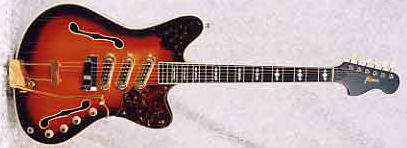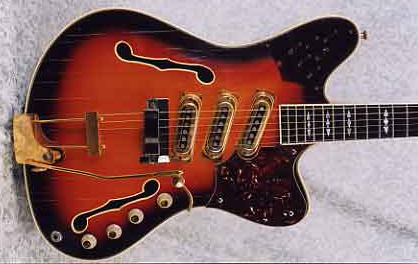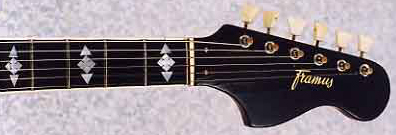“Yeah,” said the dealer, half in contempt, “and it’s got one of them there spigots.” Spigots? He didn’t realize I was a pretty cool customer in those days, able to hide my curiosity – but he’d gotten my attention. What the hell was a spigot? “You know,” he added, “you hook your pinky over it and get tremolo.” Done! That was my introduction to German electric guitars. I was, so to speak, hooked!

1963 Framus Television 5/118 Electric Guitar
What I’d gotten in that dark, dusty Philadelphia guitar shop was a 1965 Framus Strato Deluxe, essentially a solidbody version of the hollowbody 1963 Framus Television 5/118 shown here.
Now, you have to be careful about ethnic stereotypes, but since I’m half German, perhaps I may be permitted to agree that there is a Teutonic affinity for engineering. I see it in myself. You see it in German cars. And you see it in German guitars from the golden age of the 1960s like these Framus’ better models!

1963 Framus Television 5/118 Electric Guitar
Germany has a long history of instrument making going back at least to Medieval times. Framus, short for Franconian Musical Instruments, dates to 1946 when Fred Wilfer set up shop in the American controlled part of Germany in Bavaria. While they made lots of different instruments, by the mid-1950s guitars were Framus’ main product, mainly for exportation. After the Beatles hit, the American market for electric guitars mushroomed and Framus became an early supplier of the demand. Their primary American distributor was Philadelphia Music.
’60s Japanese guitars copied this neck notion. Framus was also known for its light-touch vibratos, augmented by a flip-up bridge mute for rhythm work.

1963 Framus Television 5/118 Electric Guitar
But the main attraction of Framus guitars was under the hood, in the electronics. Powered with three fat single-coil pickups, each operated by its own sliding on-off switch. Then of course there was a master volume and three tone controls, with separate on-off switches to bypass tone controls on the neck and bridge pickups.
But best of all was the spigot, known officially as the ‘Orgeltone,’ or Organ Tone, a manual tremolo with, of course, its own on-off switch. Can’t have too many of those! Basically the spigot was a volume pot that was reverse wired and spring loaded. The spigot was simply a hefty hook that you wrapped your right pinky around. As you picked the strings, you curled your pinky up and down to modulate the volume downward (reverse). The effect is a lot like an onboard Hammond organ! Orgeltone! It takes a little practice and coordination, but once mastered it’s a pretty cool low-tech engineering effect.
Framus guitars thrived as low-cost alternatives in the US until cheaper Japanese guitars and higher European labor costs phased them out. By that time the Orgeltone was also history. Gone but not forgotten, because whenever I feel like it I can limber up my pinky and let the tremolo kick in for a nifty doppelganger effect. And bring back fond memories of my first encounter with German electric guitars that fateful day in that Philly guitar shop when I was first introduced to the spigot!

Hi there, i was wondering if you would be so kind to advise me on the price for my framus semi acoustic guitar from the 60’s would be worth on the gobal market? any rough estimate would give me some sort of clue.
i appreciate it.
Kindest regards
Diana
It’s actually a cool and helpful piece of info. I am happy that you simply shared this helpful info with us. Please keep us up to date like this. Thanks for sharing.
My dad has the exact same guitar pictured here except it is a natural finish and is in pristine condition. We’ve tried for years now to find another like it. This is the 1st! Finding one with 3 pick ups and the pigot, wow!. He had his custom made to order when he was in the service stationed in Germany and brought it home in pieces and reasembled it. It’s been played but not too much and has been kept a pine case with crushed velvet lining he made himself. I love this guitar, in case you can’t tell but, tell me how can you go about finding out a value on such a rare guitar? They don’t even show it on the Framus website.
I also have a 1965 framus strato deluxe I brought back from german would like to now the value thank you jim
I have a 1963/4 my father also in the military in Germany brought it back brand new. my Framus has been played hard from 1964 to the late 70’s from recording stuido’s to on stage and in the Garage bands. it is one of the best playing guitars I have ever played. I have a total of 6 guitars from accustic to electric.. t have seen this guitar go from 1000. to 2000. mine is well used. I would like to get it to a Great Guitar shop. in Florida.
Rick
Hi!
I just bought one of these, but need schematic of the onboard wiring! Mine had six switches! I woulf really appreciate it!!!
Best regards
Tobias Karlsson in Seden
Tobias, I have the version with 6 switches. If you still need it I could open mine up and send you photos of it all along with what each switch does